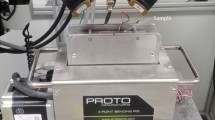Abstract
Crack extension during fracture toughness tests of ferritic structural steels cannot be determined from measurements of unloading compliance or electric potential change when the specimen is dynamically tested. Measurements of crack extension in fracture toughness tests are also very difficult when the test temperature is high or the test environment is aggressive. To circumvent this limitation, researchers for years have been developing key curve and normalization function methods to estimate crack extension in standard elastic-plastic fracture toughness test geometries. In the key curve method (Ernst et al., 1979; Joyce et al., 1980) a load-displacement curve is measured for a so-called `source' specimen that is sub size or has a blunt notch so that the crack will not initiate during elastic-plastic loading. The load and displacement are then converted to normalized stress-strain units to obtain a key curve that can be used to predict crack extension in geometrically similar `target' specimens of same material loaded at similar loading rates and tested under similar environmental conditions. More recently Landes and coworkers (Herrera and Landes, 1990; Landes et al., 1991) proposed the normalization data reduction technique – Annex A15 of ASTM 1820 specification – that presents an alternative to the standard E1820 unloading compliance procedure. Although the normalization method works well in many cases, it has serious drawbacks: the load, displacement and crack length at the end of the test must be measured; the prescribed functional form that is fitted to the initial and final data may not be accurate for all materials; and the iterative method of inferring crack length from the combination of the data and the normalization function is complex. The compliance ratio (CR) method developed in this paper determines key curves for predicting crack extension as follows. First, a statically loaded source specimen with the unloading compliance procedure specified in ASTM 1820. Second, the so-called CR load-displacement curve is calculated for the source specimen, which is the load-displacement record that would have been obtained if the crack had not extended. Third, non-dimensionalizing the CR load by the maximum load and the displacement by the elastic displacement at the maximum load, P * i/P max and v i/v el max from the source specimen yields the adjusted key curve. Analysis of extensive data shows that the key curve is independent of notch type, initial crack length and temperature. But it is dependent on specimen size and steel type. Assuming that the key curves of the source and target specimens are one and the same, the compliance of the target specimens are calculated with a reverse application of the compliance ratio method, and the crack length is obtained using the equations in ASTM E1820. The CR Method is found to be much simpler than the normalization method described in the Annex A15 of ASTM 1820. With the compliance ratio method, Joyce et al. (2001) successfully predicted crack extension in dynamically loaded specimens using a key curve of a statically loaded specimen.
Similar content being viewed by others
References
Chen, X.G., Albrecht, P., Wright, W.J. and Joyce, J.A. (1995). Improved Load Ratio Method for Predicting Crack Length. Special Applications and Advanced Techniques for Crack Size Determination, ASTM STP 1251, American Society for Testing and Materials, Philadelphia, 83–103.
Ernst, H., Paris, P.C., Rossow, M. and Hutchinson, J.W. (1979). Analysis of Load-Displacement in Relationship to Determine J-R Curve and Tearing Instability Material Properties. Fracture Mechanics, ASTM STP 677, C.W. Smith (ed), ASTM Philadelphia, 581–599.
Herrera, R. and Landes, J.D. (1990). Direct J-R Curve Analysis: A Guide to the Methodology. Fracture Mechanics, Twenty-first Symposium, ASTM STP 1074, J.P. Gudas and E.M. Hackett (eds), ASTM, Philadelphia, 24–43.
Hu, J.M., Albrecht, P. and Joyce, J.A. (1992). Load Ratio Method for estimating Crack Length. Fracture Mechanics: Twenty-Second Symposium (Volume I). ASTMSTP 1131, H.A. Ernst, A. Saxena and D.L. McDowell (eds), American Society for Testing and Materials, Philadelphia, 880–903.
Hu, J.M. and Albrecht, P. (1991). Limit Load Solution and Loading Behavior of C(T) Fracture Specimen. International Journal of Fracture, 52, 19–45.
Joyce, J.A., Albrecht, P., Tjiang, H.C. and Wright, W.J. (2001). Compliance Ratio Method of Estimating Crack Length in Dynamic Fracture Toughness Tests. Fatigue and Fracture Mechanics: 32th Volume, ASTM STP 1406, American Society for Testing and Materials, > West Conshohocken, 139–157.
Jocye, J.A., Ernst, H. and Paris, P.C. (1980). Direct Evaluation of J-Resistance Curves from Load Displacement Records. Fracture Mechanics: Twelfth Conference, ASTM STP 700, ASTM, Philadelphia, 222-236.
Kaiser, S. Three Methods of Determining the J-R Curve from a Load-Displacement Record, Report 52, Royal Institute of Technology, Stockholm, Sweden.
Landes, J.D., Zhou, Z., Lee, K. and Herrera, R. (1991). Normalization Method for Developing J-R Curves with the LMN Function, Journal of Testing and Evaluation, Vol. 19, No. 4, 305–311.
Lee, K. (1995). Elastic-plastic Fracture Toughness Determination Under Some Difficult Conditions, Ph.D. Dissertation, University of Tennessee, Knoxville, August.
Author information
Authors and Affiliations
Rights and permissions
About this article
Cite this article
Candra, H., Wright, W.J. & Albrecht, P. Experimentally determined key curves for fracture specimens. International Journal of Fracture 117, 247–267 (2002). https://doi.org/10.1023/A:1022007616892
Issue Date:
DOI: https://doi.org/10.1023/A:1022007616892




